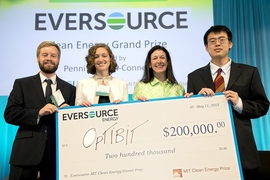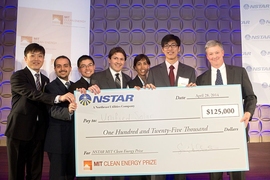As renewable energy technologies, such as wind and solar power, become increasingly attractive power sources for the grid, industry is looking for better energy-storage systems that can make these sources more cost effective.
On April 13, Lithio Storage, a team from Tufts University and Northwestern University, took home the $100,000 grand prize at the MIT Clean Energy Prize (CEP) for tackling one major challenge for grid-scale energy storage: extreme temperatures. The startup is developing an electrolyte that helps batteries withstand much broader temperature ranges, making them safer, more energy efficient, and cheaper to operate.
Using the electrolyte at wind and solar power farms, for instance, could save millions of dollars annually in operation costs, according to the startup. The electrolyte can also be used to improve battery performance in electrical vehicles.
“When you open a battery now, it’s essentially using the same materials it used 20 years ago,” said team member Anthony D’Angelo, a PhD chemical engineering student at Tufts, in his winning pitch. “There’s really a need for a more robust and energy-efficient battery.”
Lithio was one of four teams, including one from MIT, to win prize money at the nation’s largest energy-innovation competition for students from universities around the nation. Now in its 11th year, the student-run CEP has dished out more than $2.6 million to help launch clean-energy startups. Past teams have collectively raised more than $430 million in additional funding after the competition and have employed more than 700 people around the globe.
Winning a second-place prize for $20,000 was PolarPanel, a team modifying a NASA-developed solar refrigeration system to power refrigerated railcars along the supply chain. Excess energy from the system is stored as ice inside the railcar to maintain temperatures, even without sunlight. This retrofit system replaces the diesel generators that currently keep the nation’s 14,000 refrigerated railcars cold, burning an estimated $20,000 to $25,000 in diesel fuel per railcar annually.
Two additional prizes for $10,000 went to Fiat Flux, an MIT team, and Safi Analytics.
Fiat is developing a light-based technology that continuously cleans organic contaminants off seawater reverse-osmosis filters. Accumulated contaminant fouling blocks the membrane pores, which requires increasing pumping energy to blow past the blockage and maintain flow. Fiat is developing a coating to place over an existing commercial membrane. Upon exposure to ultraviolet light, any particles that have built up on the coating disintegrate, cleaning the membrane. This can drastically reduce operation costs and increase efficiency and water output, according to the team.
“At Fiat Flux, we have developed a special membrane system that uses the power of light to clean itself,” said team member Alvin Tan, an MIT PhD student in materials science and engineering, in his pitch.
Safi is developing smart technologies for factory managers in emerging markets to better manage and observe operations. The startup places sensors on equipment and has developed a platform that collects the sensor data to provide real-time information and alerts on machine breakdowns, energy usage, machine idling, unexpected power shifts, and other parameters. The team is based in Nairobi, where it currently has two live factory deployments.
This year, 17 semifinalist teams were selected to showcase their innovations to judges and attendees in four categories: generating energy, improving energy usage, delivering energy, energy for developing economies. Showcases took place during an all-day event at the Samberg Conference Center that included keynotes from “cleantech” industry executives. After the showcase, judges selected four finalist teams — one from each category — for a final pitch competition.
The judges were ultimately swayed by Lithio’s promise to improve battery performance for the electrical grid and, potentially, electric cars.
In Lithio’s pitch, D’Angelo explained that the traditional lithium-ion batteries used for grid-scale energy storage, which are about the size of refrigerators, get very hot, very quickly. If batteries hit around 50 degrees Celsius, which they can within just an hour or two, the electrolyte starts to degrade, which corrodes the battery and shortens its lifespan. After a dozen or so cycles, capacity drops about 80 percent, D’Angelo said, “making the battery essentially unusable, and then you have to purchase another one.”
Industry currently uses HVAC systems, powered by the battery, to control temperatures. This contributes to energy-efficiency losses and amounts to about 8 percent of all operating costs, D’Angelo said. For instance, he said, not using HVAC for one of Tesla’s 20-megawatt Powerpack systems — which can be used to store energy for wind and solar farms to power about 2,500 homes — could save about $5 million in operating costs annually.
Lithio’s electrolyte is a custom solution made of commercially available chemicals that binds to a battery’s lithium, making it far more stable. It can be implemented into existing commercial battery manufacturing processes to provide a wider “thermostability window,” D’Angelo said. Batteries with the electrolyte can reach temperatures ranging from -40 degrees C to 80 C without degrading. This means that while commercial batteries may last roughly 10 to 20 cycles before needing replacement, Lithio-enhanced batteries can last up to 100 cycles, even in harsh environments. In electric cars, the electrolyte could help batteries operate better in extremely hot and cold regions of the world.
With the prize money, Lithio will purchase equipment to conduct high-throughput, large-scale testing on its batteries. “We’re trying to get some field testing we need to do to get in the door with major partnerships,” D’Angelo told MIT News.
Keynote presentations were delivered by Alicia Barton, president and CEO of the New York State Energy Research and Development Authority, and Tibor Toth, director of investments at the Massachusetts Clean Energy Center.












